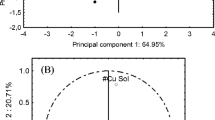Abstract
The repeated use of Cu fungicides to control coffee berry disease can result in increased Cu content in soils and vegetation and thus raising the pollution levels and a concern for potential effects on human health. Therefore a field survey of coffee orchards of the Kilimanjaro and Arusha regions of Tanzania, where Cu fungicides are frequently used, was conducted to determine the possible Cu contamination of soils and vegetation. Soil samples were collected from 0–5, 5–15 and 15–30 cm depth at a distance of 0.5 m from the trunk of coffee trees. Plant leaf samples of beans and maize crops intercropped with coffee trees as well as leaves of coffee trees, were also collected at the same time and places. Soil and plant samples were collected both from small farms and commercial estates. Copper in the soil samples was extracted with CaCl2 (CCu), whereas for the total Cu, samples were digested with aqua regia (HNO3 and HCl(1:3) (ACu)). Plant samples were drying ashed and digested with HNO3. Copper concentration in the extracted and digested solutions was determined with atomic absorption spectrophotometry. A significant Cu enrichment of the soils was observed and the Cu concentration in the 0–5 cm soil depth was about three times higher than in the 15–30 cm depth. A large variability in the soil Cu concentration between fields of the same farm and within the same orchard was observed. The differences in the total Cu concentration (ACu) between small farms and commercial estates were not statistically significant, but the extractable Cu (CCu) was higher and soil pH was lower in the estates of the Kilimanjaro region than at small farms. The soil organic carbon (SOC) content increased significantly with increasing altitudes, and it was also higher on small farms than on commercial estates. The SOC content showed a close and positive correlation with total Cu. At soil pH below 5.3, the CCu fraction increased steeply. Bean plants from coffee fields showed a high concentration of Cu, suggesting a possible Cu toxicity problem in bean plants. Coffee leaves also showed extremely high Cu concentration.
Similar content being viewed by others
References
Aasen I. 1997. Mangelsjukdomar og andre ernæringsforstyrringar hos kulturplanter. Landbruksforlaget, AiT Enger AS, Otta, 96 pp.
Baker D.E. 1990. Copper. In: Alloway B.J (ed), Heavy Metals in Soils. Blackie Academic, Glasgow, UK, pp. 151-175.
Bennet J.P., Chiriboga E., Coleman J. and Walker D.M. 2000. Heavy metals in wild rice from northern Wisconsin. Sci. Total Environ. 246: 261-269.
Brun L.A., Maillet J., Richarte J., Herrman P. and Remy J.C. 1998. Relationships between extractable copper, soil properties and copper uptake by wild plants in vineyard soils. Environ. Pollut. 102: 151-161.
Cavallaro N. and Mc Bride M.B. 1978. Copper and cadmium adsorption characteristics of selected acid and calcareous soils. Soil Sci. Soc. Am. J. 42: 550-556.
Christensen R. 1996. Applied Statistical Methods. Chapman & Hall, London, p. 587.
Fageria N.K., Baligar V.C. and Jones C.A. 1991. Growth and Mineral Nutrition of Field Crops. Marcel Dekker Inc., New York, p. 476.
Frostegård Å., Tunlid A. and Bååth E. 1993. Phospholipid fatty acid composition, biomass, activity of microbial communities from two soil types experimentally exposed to different heavy metals. Appl. Environ. Microbiol. 59: 3605-3617.
Helrich K. 1990. Official Methods of Analysis, Vol. 8A(1). Association of Analytical Chemists Inc., Gaithersburg, MD, pp. 20-24.
Hooda P.S. and Alloway B.J. 1994. The plant availability and DTPA extractability of trace metals in sludge-amended soils. Sci. Total Environ. 149: 39-51.
Houba V.J.G., Lexmond T.M., Novozamsky I. and Van der Lee J.J. 1996. State of the art and future development in soil analysis for bioavailability assessment. Sci. Total Environ. 178: 21-28.
Jeng A.S. and Bergseth H. 1992. Chemical and mineralogical properties of Norwegian alum shale soils, with special emphasis on heavy metal content and availability. Acta Agric. Scandinavia. A., Soil Plant Sci. 42: 88-93.
Lehman R.M. and Mills A.L. 1994. Field evidence for copper mobilization by dissolved organic matter. Water Res. 28: 2487-2497.
Lepp N.W. and Dickinson N.M. 1994. Fungicide derived Cu in tropical plantation crops. In: Ross S. (ed.), Toxic Metals in Soil-Plant Systems. John Wiley and Sons Inc., New York, pp. 367-393.
McBride M., Sauvé S. and Hendershot W. 1997. Solubility control of Cu, Zn Cd and Pb in contaminated soils. Eur. J. Soil Sci. 48: 337-346.
McGrath S.P., Sanders J.R. and Shalaby M.H. 1988. The effects of organic matter levels on soil solution concentration and extractability of manganese, zinc and copper. Geoderma 42: 177-188.
Noad T. and Birnie A. 1986. Trees of Kenya. General Printers, Nairobi, Kenya, p. 308.
Semu E. and Singh B.R. 1996. Accumulation of heavy metals in soils and plants after long-term use of fertilisers and fungicides in Tanzania. Fert. Res. 44: 241-248.
Singh B.R. and Mishra V.K. 1987. Mineral content of grasses and grasslands of theHimalayan region: 2. Concentration of trace and major elements in grasses in relation to soil properties and climatic factors. Soil Sci. 143: 241-256.
Wrigley G. 1988. Coffee. John Wiley and Sons, Inc., New York, p. 639.
Author information
Authors and Affiliations
Rights and permissions
About this article
Cite this article
Loland, J., Singh, B. Copper contamination of soil and vegetation in coffee orchards after long-term use of Cu fungicides. Nutrient Cycling in Agroecosystems 69, 203–211 (2004). https://doi.org/10.1023/B:FRES.0000035175.74199.9a
Issue Date:
DOI: https://doi.org/10.1023/B:FRES.0000035175.74199.9a




